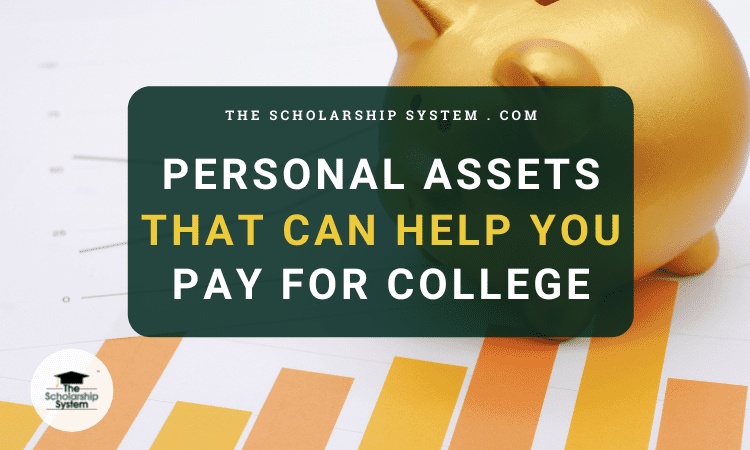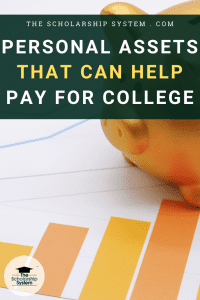Updated on May 20th, 2024
Figuring out how to pay for your child’s college education can be daunting. If your student has a shortfall, then figuring out if any personal assets are viable options for making up the difference is wise.
Even if your child could cover it with student loans, choosing to use certain personal assets to pay for college might be a better direction.
If you want to explore which options might be available to you, here are a few worth considering.
Please note: We are not financial advisors. You should always speak with your Certified Financial Planner or Advisor before deciding to tap into financial assets for college.
529 College Savings Plans
529 College Savings Plans are personal assets designed to help students pay for college. Plus, they are factored into FAFSA calculations (albeit minimally), affecting your child’s ability to secure need-based aid.
By using funds from a 529 plan to pay for college, you increase your student’s eligibility for need-based aid in subsequent years and put the money towards its intended purpose. Additionally, by directing the money to qualifying college expenses, you avoid paying taxes on any earnings, which is a bonus in and of itself.
Ultimately, by directing 529 savings towards your child’s educational expenses, you are allowing these personal assets to serve their ideal purpose, making college more affordable for your student.
Savings: One of the Best Personal Assets for College Tuition
When it comes to paying for college, cold hard cash is hard to beat. Even if you can’t pay for college entirely with savings, this is one of your personal assets that smart to tap.
Why? Because savings accounts typically don’t earn much interest. Even high-yield savings accounts generally don’t make more than 1 percent annually, which usually doesn’t beat inflation, let alone the interest rate on a student loan.
Plus, money in savings is factored into your student’s FAFSA, lowering the amount of financial aid they receive.
Cashing Out Non-Retirement Investment Accounts
Stocks, bonds, CDs, money market, mutual funds, and other non-retirement investments are other personal assets that are factored into FAFSA calculations. Having these forms of investments can lower the amount of financial aid your student qualifies for, increasing the odds that they will need scholarships, loans, or other sources of money to pay for college.
Cashing out your non-retirement investment accounts can free up funds to help cover your child’s tuition. Plus, in subsequent years, they may qualify for additional financial aid based on their FAFSA, decreasing the out-of-pocket expense. If you are curious why college tuition is so high, read this article.
However, you don’t want to rush to cash out these personal assets without doing some research. If an investment is earning more in interest than a student loan costs, you’ll experience a net loss.
For example, if your investment account is earning 8 percent annually, and your student qualifies for federal Direct Subsidized or Direct Unsubsidized loans at 4.45 percent (the current amount for disbursals before July 2018), keeping the investment may be a smarter financial decision as long as the impact to your child’s FAFSA is minimal. This is especially true for subsidized loans where they don’t begin to accrue interest until after your student graduates.
If your investment is earning more, but you still want to free your child from student loan debt, you can always cash out once payments are due. This allows you to earn interest while they are in school, creating a net gain, yet still cover the costs.
But, if you discover that your personal assets held as investments aren’t earning more in interest than a student loan costs, using your non-retirement accounts to pay for college can be a great option. This is similarly true if cashing out and using the money to pay their tuition allows them to access more financial aid based on their subsequent FAFSA and creates a net gain situation.
Related articles:
Real Estate as Personal Assets to Help Pay for College
If you own real estate, with or without a current mortgage, it can be a vehicle for paying for your child’s college. Typically, you have a few options for using these personal assets, depending on the property type, its value, and the remaining amount you owe.
Home Equity
Home equity can be a source of money to help pay for college. Generally, you’ll need to take out a home equity loan, do a cashback refinance, or open a home equity line of credit to access these funds.
The amount you can take out varies depending on your situation. For example, between your mortgage and any subsequent home-related credit, you might need to leave at least 20 percent in equity untapped to satisfy the lender and avoid costly PMI.
Lenders have a lot of say regarding the use of home equity. Each institution can set its own standards regarding qualifying, interest rates, fees, and more. In some cases, the interest rate and fees would cost more than securing a student loan for a similar amount, so you’ll need to see what costs come with using your home as a source of money for college expenses.
It’s also important to note that your house serves as collateral for these loans and lines of credit. If you fail to repay the lender, they can attempt to foreclose on your home. Typically, a family’s home is one of their most valuable personal assets, so this decision shouldn’t be taken lightly.
Secondary Properties
If you own additional properties, such as rentals or vacation homes, then you have some options here as well. For example, you can use equity on the property to fund your child’s education or sell it if you don’t need it.
Ultimately, you have to determine if these personal assets need to be maintained or if you can let them go. Income-generating properties may produce enough money to make them worth keeping, and vacation homes provide you with enjoyment that would otherwise be unaffordable.
However, you do have options for using these personal assets as a way to pay for college, so it’s worth exploring if you haven’t considered it already.
Qualifying Retirement Accounts
Typically, tapping your retirement accounts for purposes other than retirement isn’t ideal. These personal assets provide you with security after you leave the working world, allowing you to live comfortable by using the money in place of traditional income.
However, if you have a Roth IRA and don’t have any other option, you can withdraw your contributions tax-free should the need arise. Additionally, if you are at least 59 ½, you can use your earnings without penalty if you’ve held the account for at least 5 years.
As long as earnings withdrawals are used for qualifying college expenses, including for your child, you won’t pay a 10 percent penalty for an early withdrawal. However, you will owe taxes on the money.
Additionally, there is no benefit on the FAFSA for using personal assets in retirement accounts. These funds aren’t used in FAFSA calculations for need-based aid, so only choose this option if no other choice remains.
Other Personal Assets Worth Exploring
In some cases, you may have additional personal assets that could help your child pay for college. Vehicles, collectibles, art, and antiques, and similar items, may all have value.
Generally, you would have to sell these items if you want to help with college tuition. In some cases, this can be challenging, particularly if you want top dollar.
For example, art and antiques may require you to work with a reputable dealer or auction house, which means you’ll need to pay a commission. Further, it can take a lot of time to find a suitable buyer, so some of these personal assets might not be very liquid.
But, if you happen to have some valuable items on-hand and are willing to part with them, it doesn’t hurt to see what they are worth and determine if selling them would be a smart decision.
Ultimately, which personal assets you choose to use to help your student pay for college will always be a personal choice. Just make sure, if you do use some of your assets, that you’ll experience a net gain when compared to securing student loans or other options. That way, you know you are coming out ahead, which is usually the most important goal.
If you and your student would like to learn more about how to find scholarships that can help pay for college, sign up for our free college scholarship webinar! We cover how to spot the scams so you can make sure your student is applying to scholarships that are actually worth their time. Join the next free training here: www.thescholarshipsystem.com/freewebinar.




Leave a Reply